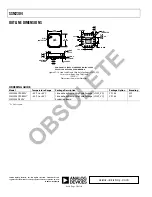
SSM2304
Rev. 0 | Page 13 of 20
APPLICATION NOTES
OVERVIEW
The SSM2304 stereo Class-D audio amplifier features a filterless
modulation scheme that greatly reduces the external components
count, conserving board space and thus reducing systems cost.
The SSM2304 does not require an output filter, but instead relies
on the inherent inductance of the speaker coil and the natural
filtering of the speaker and human ear to fully recover the audio
component of the square-wave output. While most Class-D ampli-
fiers use some variation of pulse-width modulation (PWM), the
SSM2304 uses a Σ-Δ modulation to determine the switching
pattern of the output devices. This provides a number of important
benefits. Σ-Δ modulators do not produce a sharp peak with
many harmonics in the AM frequency band, as pulse-width
modulators often do. Σ-Δ modulation provides the benefits of
reducing the amplitude of spectral components at high frequencies;
that is, reducing EMI emission that might otherwise be radiated
by speakers and long cable traces. The SSM2304 also offers
protection circuits for overcurrent and temperature protection.
GAIN SELECTION
The SSM2304 has a pair of internal resistors that set an 18 dB
default gain for the amplifier.
It is possible to adjust the SSM2304 gain by using external resistors
at the input. To set a gain lower than 18 dB refer to Figure 37 for
differential input configuration and Figure 38 for single-ended
configuration. The external gain configuration is calculated as
External Gain Settings
= 376 kΩ/(47 kΩ + Rext)
POP-AND-CLICK SUPPRESSION
Voltage transients at the output of audio amplifiers can occur when
shutdown is activated or deactivated. Voltage transients as low
as 10 mV can be heard as an audio pop in the speaker. Clicks
and pops can also be classified as undesirable audible transients
generated by the amplifier system, therefore as not coming from
the system input signal. Such transients can be generated when
the amplifier system changes its operating mode. For example, the
following can be sources of audible transients: system power-up/
power-down, mute/unmute, input source change, and sample rate
change. The SSM2304 has a pop-and-click suppression architecture
that reduces these output transients, resulting in noiseless activation
and deactivation.
EMI NOISE
The SSM2304 uses a proprietary modulation and spread-
spectrum technology to minimize EMI emissions from the
device. Figure 39 shows SSM2304 EMI emission starting from
100 kHz to 30 MHz. Figure 40 shows SSM2304 EMI emission
from 30 kHz to 2 GHz. These figures clearly describe the SSM2304
EMI behavior as being well below the FCC regulation values,
starting from 100 kHz and passing beyond 1 GHz of frequency.
Although the overall EMI noise floor is slightly higher, frequency
spurs from the SSM2304 are greatly reduced.
70
0
0.1
100
FREQUENCY (MHz)
LE
V
E
L (
d
B
(µ
V
/m
))
60
50
40
30
20
10
1
10
= HORIZONTAL
= VERTICAL
= REGULATION VALUE
06
16
2-
03
2
Figure 39. EMI Emissions from SSM2304
70
0
10
10k
FREQUENCY (MHz)
LE
V
E
L (
d
B
(µ
V
/m
))
60
50
40
30
20
10
100
1k
= HORIZONTAL
= VERTICAL
= REGULATION VALUE
06
16
2-
03
3
Figure 40. EMI Emissions from SSM2304
The measurements for Figure 39 and Figure 40 were taken with
a 1 kHz input signal, producing 0.5 W output power into an 8 Ω
load from a 3.6 V supply. Cable length was approximately 5 cm.
The EMI was detected using a magnetic probe touching the 2”
output trace to the load.
OBSOLETE




















